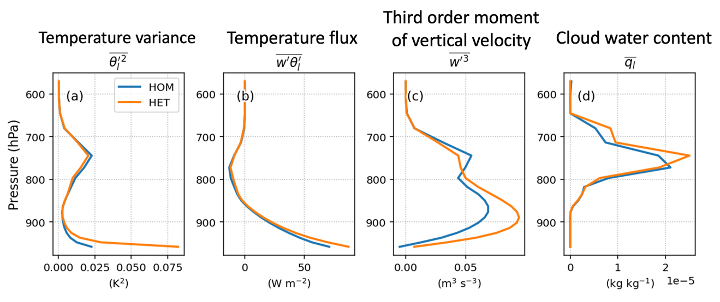Atmosphere Response to Land Surface Diversity
The type and composition of landforms affect atmospheric properties and clouds in a state-of-the-art Earth system model.
The Science
The land surface plays a crucial role in regulating the water and energy cycles in the lower atmosphere. The land component of Earth system models can represent a variety of landform types and their respective status in a single grid cell. However, the model only communicates the grid mean with the overlying atmosphere. This neglects the land surface diversity within grid cells in land-atmosphere interactions. A new study reveals that including land diversity in land-atmosphere interactions changes the heat and moisture transport in the lower atmosphere and increases low-level clouds.
The Impact
This research offers an initial assessment of representing land surface diversity in the land-atmosphere interactions of a state-of-the-art Earth system model. The results show that a new mathematical representation, or parameterization, improves the mechanistic understanding of atmospheric responses to complex land surface conditions. Since clouds play an essential role in the climate system, the significant impact of this parameterization on the low-level clouds highlights the importance of better representing diverse landform types in land-atmosphere interactions in next-generation Earth system models.

Figure 1. The new land-atmosphere coupling parameterization (orange lines) introduces more subgrid-scale surface variability than the original treatment (blue lines). This increase in temperature variance extends from the surface to the lower atmospheric boundary layer, affects the turbulent fluxes, and ultimately leads to a significant increase in the cloud water mixing ratio.
Summary
Researchers implemented a new parameterization into the Energy Exascale Earth System Model (E3SM) to better represent land surface heterogeneity at a subgrid scale. They performed two single-column model simulations over the Atmospheric Radiation Measurement (ARM) Southern Great Plains (SGP) site during the summer. The comparison between the new treatment and default model representation showed that under the new treatment, the land surface demonstrates considerably more subgrid variability in temperature and humidity. This discrepancy can extend through half of the atmospheric boundary layer, affecting the turbulent transport of heat and moisture (Fig. 1). As land surface diversity increases, so does the amount of shallow clouds. Initial evaluation of the simulations against observations show potential improvements in some aspects and degradation in others, suggesting the possible presence of compensating errors. Further model evaluation and analysis is ongoing to better understand the various impacts of the new parameterization and results will be documented in a separate manuscript. The present study improves our mechanistic understanding and emphasizes the importance of correctly representing land surface conditions and their interaction with the atmosphere in next-generation Earth system models.
Publication
- Representing surface heterogeneity in land–atmosphere coupling in E3SMv1 single-column model over ARM SGP during summertime, Huang, Meng, Po-Lun Ma, Nathaniel W. Chaney, Dalei Hao, Gautam Bisht, Megan D. Fowler, Vincent E. Larson, and L. Ruby Leung. 2022. “Representing Surface Heterogeneity In Land–Atmosphere Coupling In E3Smv1 Single-Column Model Over Arm Sgp During Summertime”. Geoscientific Model Development 15 (16). Copernicus GmbH: 6371-6384. doi:10.5194/gmd-15-6371-2022.
Funding
- This work was supported by the Earth System Model Development program area of the Department of Energy, Office of Science, Biological and Environmental Research program.
Contact
- Po-Lun Ma, Pacific Northwest National Laboratory
This article is a part of the E3SM “Floating Points” Newsletter, to read the full Newsletter check:



